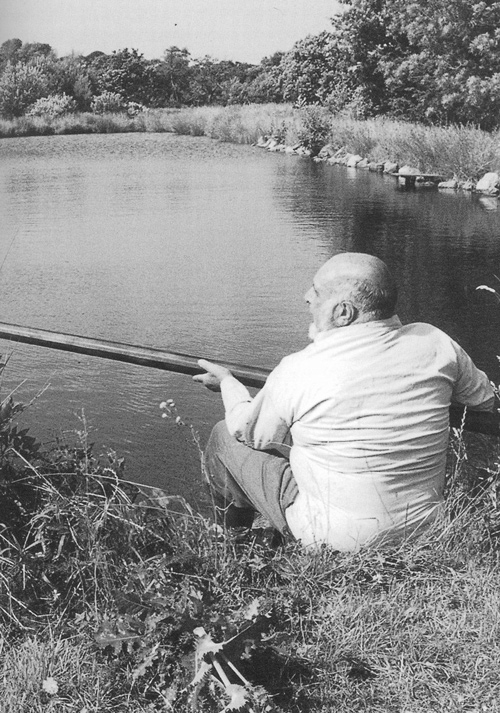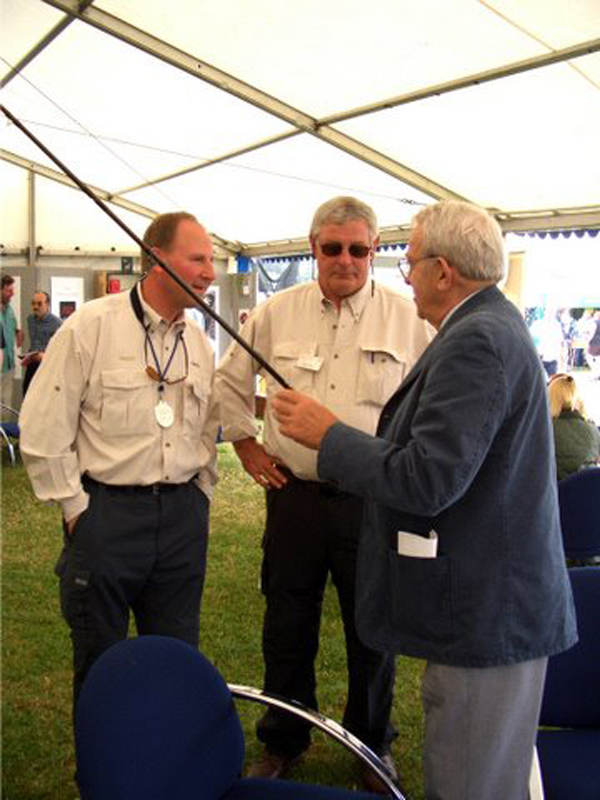When Angling Heritage (AH)
started out in 2009, it was set up as a website-based archive where people
could read articles, see films and listen to recordings helping to preserve the
rich and diverse history of angling.
However, as time passed AH was offered historic rods which, by forming a
link with Torrington
Museum, enabled them to
be displayed for all to see.
 The oldest style of rod on show was
manufactured for Fred Buller MBE to replicate the rod described in the Book of St. Albans in the Treatyse
of Fysshynge with an Angle thought to be published in 1450: the oldest book
describing fishing in the British Isles
believed to be written by Dame Juliana. This rod is telescopic and about 12’
long, made from hazel, and described as being bored out with the crank from a
spit. This one wasn’t made that way but it does generally replicate the rod.
There is also a shorter and more useable rod. The photograph shows Fred J
Taylor using this rod from the book on Dame Juliana written by Buller and Hugh
Falkus
The oldest style of rod on show was
manufactured for Fred Buller MBE to replicate the rod described in the Book of St. Albans in the Treatyse
of Fysshynge with an Angle thought to be published in 1450: the oldest book
describing fishing in the British Isles
believed to be written by Dame Juliana. This rod is telescopic and about 12’
long, made from hazel, and described as being bored out with the crank from a
spit. This one wasn’t made that way but it does generally replicate the rod.
There is also a shorter and more useable rod. The photograph shows Fred J
Taylor using this rod from the book on Dame Juliana written by Buller and Hugh
Falkus
In 1740 in The British Angler by Williamson, he
describes rods being made of hazel in the butt section (or ash or willow) with
higher sections being produced from hazel, (or yew, crabtree or blackthorn).
However he says bamboo is sometimes thought to be the best, which leads into
the next rods on display.
These are Frederick Halford’s
bamboo coarse and sea rods. Halford is best known as an exponent (not
exclusively) of dry fly fishing. These are from around the end of the
nineteenth century.
Then there are a batch of
split cane rods, the oldest being one of the first batch of Richard Walker’s Mk
IV carp rods produced by B James, known as signature rods. It is said there
were only 26 made, but it is possible that the number may be higher at around
30.
 Other split cane rods include
one of Frank Sawyer’s Pezon & Michel. Frank was a key figure in the
development of nymph fishing proucing flies from his experiences as the river
keeper at Upavon. There are four cane rods that belonged to Chris Yates; a
Hardy Perfection Roach Rod on which he caught chub and barbel, but oddly no
roach; a Mark IV Carp rod which he purchased on the banks of Redmire, and a
heavily used little Allcock’s spinning rod. Perhaps the most famous of his rods
on display is the three piece Barbus Maximus made as a prototype by Edward Barder
for “A Passion for Angling”. Chris
kept this rod although the handle was subsequently re-shaped from its
television appearance. All future Barbus Maximus were made as three piece rods.
Other split cane rods include
one of Frank Sawyer’s Pezon & Michel. Frank was a key figure in the
development of nymph fishing proucing flies from his experiences as the river
keeper at Upavon. There are four cane rods that belonged to Chris Yates; a
Hardy Perfection Roach Rod on which he caught chub and barbel, but oddly no
roach; a Mark IV Carp rod which he purchased on the banks of Redmire, and a
heavily used little Allcock’s spinning rod. Perhaps the most famous of his rods
on display is the three piece Barbus Maximus made as a prototype by Edward Barder
for “A Passion for Angling”. Chris
kept this rod although the handle was subsequently re-shaped from its
television appearance. All future Barbus Maximus were made as three piece rods.
Fibreglass rods started to
appear post World War II, often solid, but later hollow to reduce the weight. There
are two prototype Hardy ‘Fred J Taylor Touch Leger Rods’, featured based on the ‘Supalite Fly Rod’ blanks, (one three
inches longer than the other) and one of the only two ‘Chevin’ rods made for
Fred J and his son-in-law Ian Howcroft (who wrote under the pen name Chevin).
There are also rods previously owned Peter Stone, and Gerry Savage who
pioneered angling broadcasting with his weekly radio series originally on BBC
Medway and then Radio London. (You can hear several of these broadcasts in the
AH audio archive)
 Finally, there is the first
carbon fibre rod ever made in a collaboration between Hardy’s, The Royal Aircraft
Establishment at Farnborough and the Moncrieff Rod Development Company founded
by Leslie Moncrieff and Fred Buller , with Richard Walker and Fred J Taylor
later joining. This was made from early carbon
fibre tows and was intended as spinning rod but proved to be so powerful that
it was given to Fred Buller who used it for deadbaiting in Lough Corrib where
he had his Irish cottage. He said it was perfect for casting mackerel. Later
production of the tows was more pliable and better suited to rod making.
Finally, there is the first
carbon fibre rod ever made in a collaboration between Hardy’s, The Royal Aircraft
Establishment at Farnborough and the Moncrieff Rod Development Company founded
by Leslie Moncrieff and Fred Buller , with Richard Walker and Fred J Taylor
later joining. This was made from early carbon
fibre tows and was intended as spinning rod but proved to be so powerful that
it was given to Fred Buller who used it for deadbaiting in Lough Corrib where
he had his Irish cottage. He said it was perfect for casting mackerel. Later
production of the tows was more pliable and better suited to rod making.
If you wish to know more
about carbon fibre rod development, there is an excellent article written by
James Barlow on the Angling Heritage website http://www.anglingheritage.org/p-26863-2018-the-golden-anniversary-of-the-carbon-fibre-fishing-rod.aspx